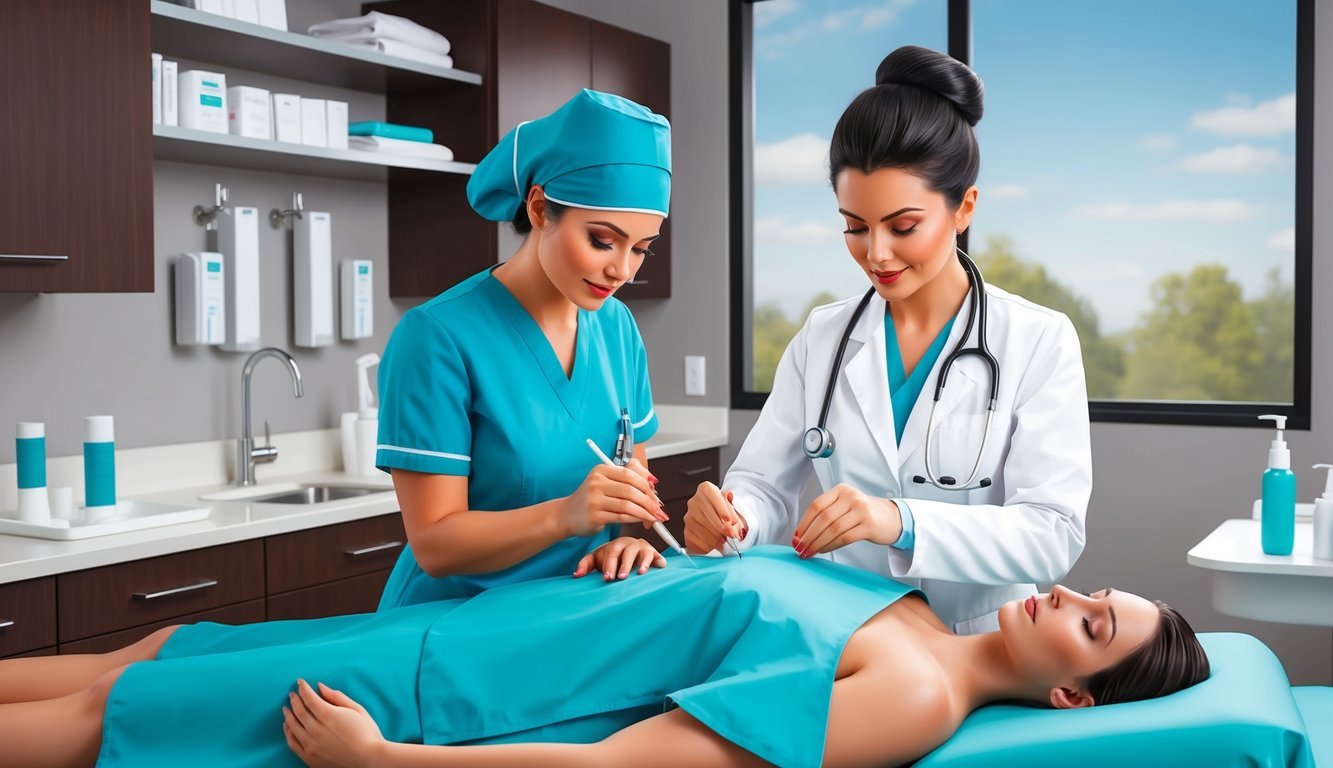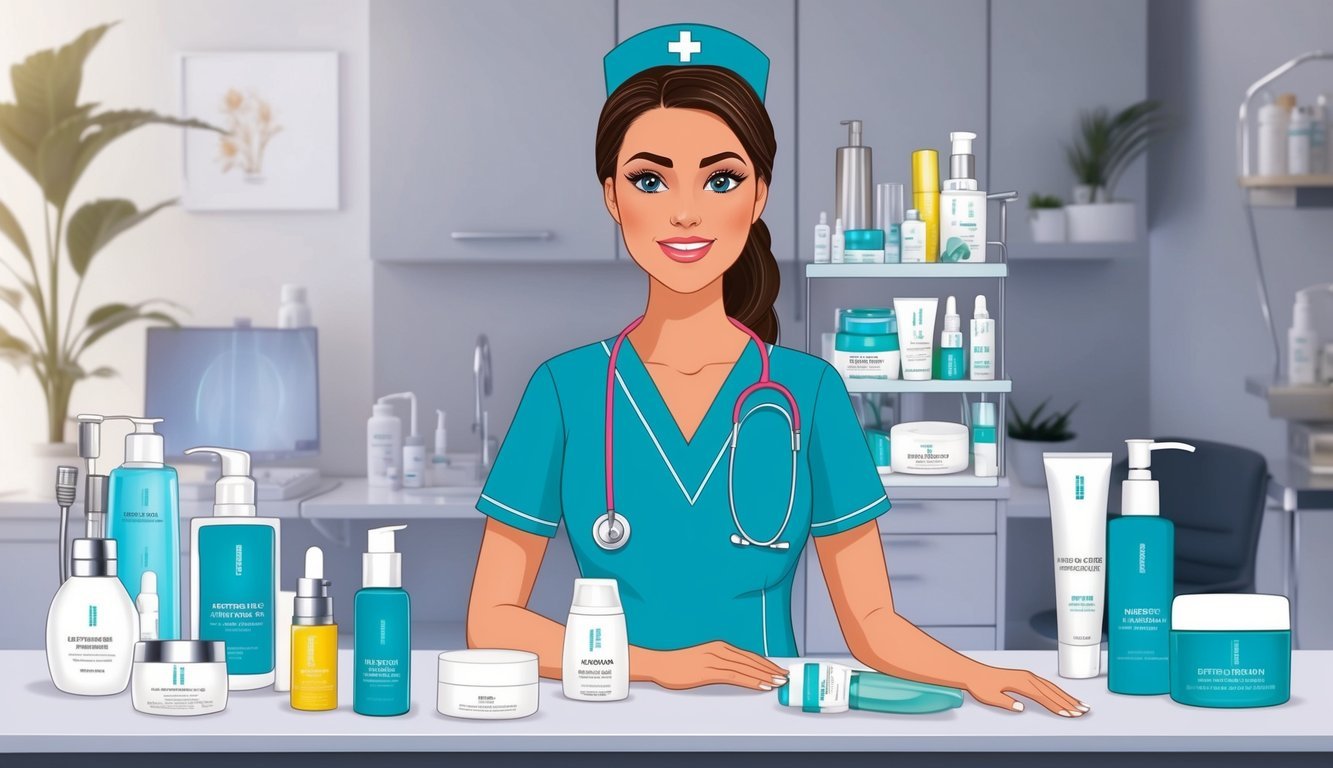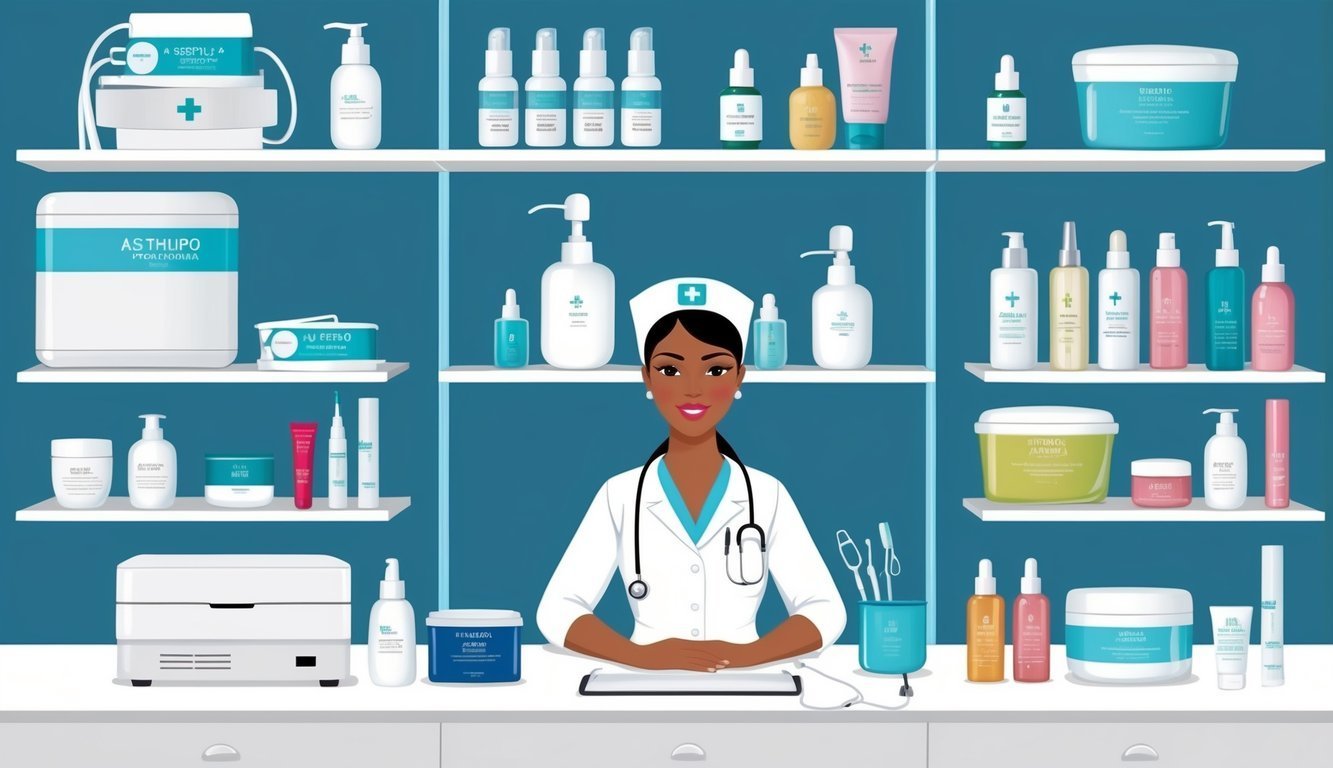As an aesthetic nurse practitioner, you play a crucial role in the expanding field of aesthetic medicine.
These professionals specialize in delivering cosmetic procedures that enhance patients’ appearance and boost their self-confidence.
The average salary for this career is around $130,295 per year, making this a promising choice if you are interested in combining nursing skills with aesthetic treatments.
Your journey begins with obtaining a nursing degree, which may include either an associate’s or a bachelor’s degree in nursing.
From there, additional training in cosmetic procedures is essential to develop the skills needed for this specialized field.
Aesthetic nurse practitioners work primarily in clinics, private practices, and medical spas, focusing on non-invasive and minimally invasive procedures that cater to client needs.
If you are passionate about beauty and healthcare, becoming an aesthetic nurse practitioner might be the perfect career path for you.
By combining your nursing expertise with advanced skills in aesthetic medicine, you can create transformative experiences for your patients while enjoying a rewarding career.
For more insights about this profession, explore resources on how to become an aesthetic nurse practitioner.
Becoming an Aesthetic Nurse Practitioner
To pursue a career as an aesthetic nurse practitioner, you need to navigate specific educational requirements, obtain the necessary certifications and licensure, and understand pathways for career advancement.
Each step in this process is crucial for achieving your goal.
Educational Path
Your journey begins with obtaining a Registered Nurse (RN) degree, which can be achieved through an Associate Degree in Nursing (ADN) or a Bachelor of Science in Nursing (BSN).
Many choose to pursue an RN-to-BSN program to enhance their education.
After earning your RN degree, the next step is to pursue advanced education, such as a Master of Science in Nursing (MSN) or a Doctor of Nursing Practice (DNP).
These degrees are offered by accredited nurse practitioner programs and are vital for specialization in aesthetics.
Certifications and Licensure
Upon completing your advanced education, you must pass the NCLEX-RN exam to become a licensed registered nurse.
After obtaining your license, consider pursuing board certification through recognized organizations.
Certification options include the Certified Aesthetic Nurse Specialist (CANS) credential, which is offered by the American Association of Aesthetic Medicine.
Additionally, fulfilling your continuing education requirements is necessary to maintain your licensure and stay updated on industry standards.
Career Progression
As an aesthetic nurse practitioner, your career can progress in various ways.
Many practitioners start in clinics or medical spas, gaining experience in aesthetic procedures such as injectables, laser treatments, and skin care.
With experience, you can move into roles that involve supervising other nurses or even provide training in aesthetic practices.
Additionally, continuing education and participation in workshops can help you specialize further.
Engaging in networks and associations can also open doors to new opportunities in aesthetic nursing.
Clinical Skills and Procedures

Aesthetic nurse practitioners are vital in delivering various specialized services aimed at enhancing patients’ physical appearance.
Mastery of specific clinical skills and adherence to safety protocols ensure effective outcomes and patient satisfaction.
Aesthetic Treatments and Services
As an aesthetic nurse practitioner, you will administer a variety of treatments.
These include:
- Botox: Used to reduce wrinkles by temporarily paralyzing muscles.
- Dermal Fillers: Designed to add volume and smooth out fine lines.
- Laser Treatments: Effective for skin rejuvenation, tattoo removal, and hair removal.
- Chemical Peels: Help improve skin texture and tone by removing the outer layer.
- Microdermabrasion: A non-invasive procedure that exfoliates the skin.
Developing proficiency in injection techniques is crucial.
Proper technique minimizes discomfort and maximizes effectiveness in treatments.
Safety and Compliance
Patient safety is paramount in aesthetic practices.
Thus, you must be familiar with local regulations and industry standards.
Adherence to safety protocols includes:
- Conducting thorough patient assessments to identify contraindications.
- Ensuring sterile conditions during procedures to prevent infections.
- Keeping detailed records of treatments administered.
Staying updated on the latest safety guidelines and training is essential.
Regular continuing education courses can enhance your knowledge of safety measures and compliance regulations.
Technological Proficiency
To provide high-quality care, you need to be proficient with various technologies.
This includes:
- Operating laser machines for treatments like hair removal and tattoo removal.
- Using advanced tools for sclerotherapy, targeting vascular lesions.
- Familiarity with software for managing patient records and treatment plans.
Keeping abreast of technological advancements ensures you deliver the most effective treatments.
Engaging in hands-on training workshops can further enhance your skills and confidence.
Interpersonal Aspects of Aesthetic Nursing

In aesthetic nursing, strong interpersonal skills significantly enhance patient experience and satisfaction.
Effective communication and education play crucial roles in fostering trust and managing patient expectations.
Patient-Centered Communication
Effective patient-centered communication is key to building a trusting relationship with your clients.
This involves listening actively and engaging in meaningful conversations to understand their needs.
You should ask open-ended questions to encourage patients to express their concerns and desires.
This helps in assessing their expectations more accurately.
Use clear, professional language that avoids jargon, ensuring the patient fully comprehends the procedures.
Additionally, non-verbal communication such as eye contact and appropriate body language reinforces your commitment to understanding their perspectives.
By demonstrating empathy and professionalism, you can enhance patient satisfaction and loyalty, which are vital for long-term success in aesthetic practices.
Education and Expectations Management
Education is essential for setting realistic expectations regarding aesthetic procedures.
Inform your patients about the available options, potential outcomes, and any limitations.
This transparency helps mitigate disappointments and enhances trust.
Provide resources such as brochures or links to reputable sites that outline procedures, risks, and post-care instructions.
You may also hold informational sessions to address common questions and concerns.
Offer personalized follow-up consultations to review any queries after initial discussions.
This practice allows patients to feel more involved in their care journey, ultimately leading to improved satisfaction.
Clear education not only uplifts your professionalism but significantly impacts patients’ perceptions of their results.
Professional Practice and Environment

Understanding the professional practice and environment of aesthetic nurse practitioners is crucial for navigating various settings and maintaining ethical standards.
This section discusses the scope of practice in diverse environments and the ethical and legal considerations that must be observed.
Scope of Practice in Various Settings
Aesthetic nurse practitioners (ANPs) can work in multiple environments, each with its own scope of practice.
Common settings include:
| Setting | Typical Roles | Procedures |
|---|---|---|
| Medical Spas | Perform non-invasive treatments | Botox, fillers, chemical peels |
| Dermatology Clinics | Provide specialized care for skin conditions | Laser treatments, skin assessments |
| Private Practice | Manage a range of cosmetic procedures | Aesthetic consultations, surgical assistance |
| Outpatient Settings | Focus on patient education and follow-up care | Post-procedure assessments, skincare advice |
Each environment may have specific regulations and protocols that you must follow, often dictated by state laws and facility policies.
Staying abreast of advancements in cosmetic medicine is key to providing high-quality care.
Ethical and Legal Considerations
Ethics are paramount in aesthetic practices, where patient trust and safety are essential.
Key considerations include:
- Informed Consent: Always ensure that patients understand the procedures, risks, and expected outcomes before proceeding.
- Scope of Practice: Adhere to regulations defining your capabilities, especially when utilizing technological advancements in medical aesthetics.
- Patient Confidentiality: Safeguard all patient information and only use it for intended healthcare purposes.
Adhering to these ethical guidelines can help you maintain professionalism while ensuring patient safety and satisfaction.
Following legal requirements will also protect you from potential liabilities in your practice.
Career Opportunities and Advancement

As an aesthetic nurse practitioner, you have the potential for diverse career paths and significant opportunities for advancement.
The aesthetic industry is rapidly expanding, offering a variety of specializations that cater to different interests and skills.
Furthermore, the economic outlook is promising, with competitive compensation appealing to many in the field.
Specialization and Diversification
In aesthetic nursing, you can choose to specialize in various treatments and procedures.
Options include Botox administration, dermal fillers, laser therapies, and skin rejuvenation techniques.
This specialization helps you build expertise and establish a unique niche in the market.
Many aesthetic nurse practitioners also diversify their skills by offering comprehensive consultations, understanding the latest trends in aesthetic treatments, and incorporating wellness strategies.
Such diversification can attract a broader clientele and enhance your practice.
Continuing education is crucial.
Certificates such as the Certified Aesthetic Nurse Specialist (CANS) can enhance your credentials and increase your marketability in this competitive field.
Economic Outlook and Compensation
Aesthetic nurse practitioners can expect a robust economic outlook.
Aesthetic medicine is projected to grow, fueled by increasing demand for cosmetic procedures among diverse demographics.
In 2023, nurse practitioners had a median salary of approximately $129,480 per year.
While specific figures for aesthetic NPs may vary, the average salary is around $130,295 annually, according to ZipRecruiter.
The evolving market offers numerous opportunities for career growth.
Positions can range from working in medical spas and dermatology clinics to opening your own practice.
Regular hours may provide an appealing work-life balance compared to other nursing specialties.
Investing in specialized training and certifications not only increases earning potential but also positions you for leadership roles within aesthetic practices.

